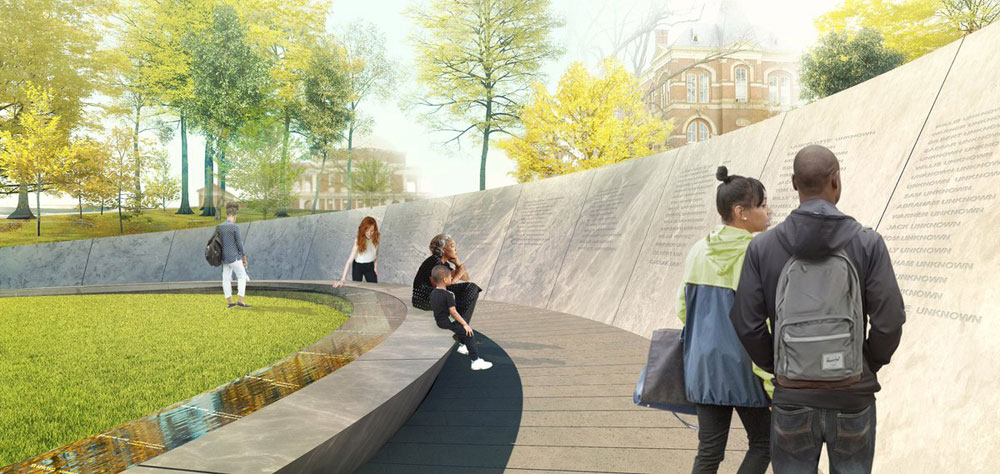
August 16, 2020; New York Times and the Washington Post
An estimated 4,000 enslaved people—including construction workers, craftsmen, domestic servants, gardeners, cooks—labored at the University of Virginia in Charlottesville between its founding in 1819 and the South’s defeat in the Civil War in 1865. Only 578 of their names are known (at least so far). Another 311 were known by their jobs or their relation to others: e.g., bricklayer, mother, son, niece.
Now a new Memorial to Enslaved Laborers recalls the university’s slave past, as well as honoring the contributions of these 4,000 people. Because the names of more than 3,000 are lost, the architects included in the granite memorial what they call “memory marks,” small gashes in the stone that stand in for the anonymous laborers.
As Phil Kennicott observes in the Washington Post, “Charlottesville is at the center of this country’s conversation about race, the legacy of slavery and the persistence of white supremacy.” This was true, he observes, long before white supremacists marched in the city’s streets in 2017 and one white nationalist rammed his car into counter-protestors, killing 32-year-old paralegal Heather Heyer and injuring 19 others. As Kennicott points out, “Idealism and cynicism were baked into the brick” of the university that Thomas Jefferson helped found.
Sign up for our free newsletters
Subscribe to NPQ's newsletters to have our top stories delivered directly to your inbox.
By signing up, you agree to our privacy policy and terms of use, and to receive messages from NPQ and our partners.
The new memorial had been scheduled to open in April before the coronavirus pandemic shut down much of the campus. The memorial, writes Kennicott, includes “a timeline of slavery at [the University of Virginia] along the inner ring and the wall of names and memory marks along the outer one.” Kennicott adds that “the exterior of the outer wall also includes a subtle (and sometimes difficult to discern) set of eyes, derived from an image of Isabella Gibbons, an enslaved woman who was owned by professors at the university before emancipation and who went on to become an educator of freed African Americans.”
The memorial also includes an engraved statement that Gibbons offered after slavery’s end in 1867. She wrote: “Can we forget the crack of the whip, cowhide, whipping-post, the auction-block, the hand-cuffs, the spaniels, the iron collar, the negro-trader tearing the young child from its mother’s breast as a whelp from the lioness? Have we forgotten that by these horrible cruelties, hundreds of our race have been killed? No, we have not, or ever will.”
But the University of Virginia—like many white institutions—did its best to forget during the 150-year period after Gibbons had written those words. It took, notes Kennicott, student activism to compel the university to build the memorial. Back in 2007, in a half-measure, the university installed, in the floor of the Rotunda, a commemorative slate plaque that read: “In honor of the several hundred women and men, both free and enslaved, whose labor between 1817 and 1826 helped to realize Thomas Jefferson’s design for the University of Virginia.” Students objected to the wording which, Kennicott notes, “sidelined the labor of enslaved people in favor of calling attention to Jefferson.” The 2007 plaque also was not situated in a central location. It was only in 2016 when university leaders agreed to campus demands and commissioned a full memorial.
“The designers of the new memorial,” notes Kennicott, “say they wanted to fulfill the need for a memorial that made an invisible, often whitewashed history visible.” Already, he adds, the memorial, located on campus, located in a place where it “can’t be missed,” is attracting a large number of visitors.—Steve Dubb













